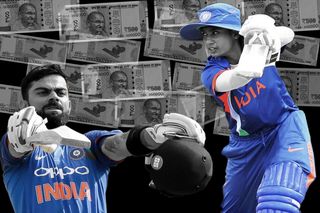
All The Arguments You Need: to Advocate for Equal Pay in Sport
For the next time you hear, “Women’s sports don’t generate as much money as men’s sports. Do you understand ROI?”

In our All The Arguments You Need series, we take on mindsets standing in the way of progress and rebut them with facts and logic.
With the final of the FIFA Women’s World Cup looming, we thought we’d do a special edition of All The Arguments You Need and explore why female athletes should be paid the same as male athletes. Because how can you watch women play football and not think about equal pay in sport? Team U.S.A. is well known to be fighting a legal battle on their home turf to be paid at the same rate as their male peers; Norway’s Ada Hegerberg – currently one of the greatest footballers out there and the only woman to win the prestigious Ballon d’Or – is sitting out the World Cup in protest of unequal pay and her country’s low investment in women’s football, compared to men’s.
We’ve already addressed the need for equal pay in general, but the gender pay gap in sport is a peculiar niche within that issue. Sport is one of the most high-profile, high-earning, most-aspired-to fields in the world. It’s also probably the most gender unequal; Hegerberg tops the list of highest-paid female footballers, with an annual income of US$431,337, while Lionel Messi, the highest-earning male footballer, earns US$140 million each year. In other words, Hegerberg is paid 0.3% of what Messi is paid. Closer to home, Indian cricket captain Mithali Raj reportedly earns Rs. 50 lakhs per year — that’s 7% of Indian cricket captain Virat Kohli’s annual Rs. 7 crore.
The global gender wage gap overall sees women earning 63% of what men earn.Establishing equal pay in sport, well – it’s a powerful statement in one of the most unfair fields that women are, quite literally, as valuable as men, their effort as valuable as men’s effort. Equal pay for female athletes also helps fix a self-perpetuating cycle of inequality within the industry. So, for the next time you hear someone say:
“Women’s sport doesn’t generate as much money as men’s sport. Do you understand ROI?”
Let’s break this down. When you talk about money generation, you’re talking about a lot of things – sports merchandising, ticket sales, ad buys, among many others – but all of this boils down to how many fans are watching, and whether that number, and its associated purchasing power, will exceed the outlay by backers, merchandisers, and advertisers. (Oh, look at that – I do understand ROI, thanks!) So, let’s first talk about the fans, where they come from, and how fandom is built.
Fandom for men’s sport is organic. Sport has always been considered an appropriate, even an epitomizing, activity and interest for men. Sure, there are problems with this (for instance, men with less interest in sport being made to feel less manly), but the one positive is that as men’s sport formalized into professional and international phenomena, fandom was in-built — therefore, automatic, assured ROI.
On the other hand, sport has, historically, and continue to be, considered inappropriate for women, both as an activity and an interest. If a woman does muster a self-sparked interest in sport, it’s likely to be social – and social fandom heavily favors the establishment: male sport. Men’s sport is so heavily embedded in our social interactions and culture that women are routinely advised to bone up on male teams they have no interest in, just to be able to participate in office small talk and advance their careers. Women’s sport? Not so much. But let’s say a woman does, somehow, with little-to-no encouragement or social logic, muster an abiding passion for a woman’s sports team. How is she going to access it? Women’s mobility is much more restricted than men’s — from outright legal barriers (Saudia Arabia’s driving ban) to social barriers (‘sure you can go, if your brother goes with you’), and self-imposed barriers (fear for personal safety while traveling at night) — meaning a woman is likely to have more difficulty in attending a match. But that’s a niche part of profit – most money comes from fans watching online or on TV. Yet women, within their own households, are less likely than men to get to control the TV remote. They are much less likely than men to have a mobile internet connection that would allow them to stream or follow a match.
In other words, it’s not that consumers value men’s sport and male athletes more, in turn making the same more valuable to companies; it’s male-ness that ensures companies’ high ROI on men’s sport and male athletes. Therefore, while establishing a profitable fanbase for women’s sport is hardly impossible, it can’t possibly be purely organic, as is the case for men’s sport. It will take actual investment in order to see a non-guaranteed return. It takes risk — and that’s not the fault of individual women athletes or their teams; it’s the fault of society. So, why are we punishing these women with unequal pay?
But let’s look at what happens when companies take that risk based on the assumption that women’s sport has the potential to be profitable. Nike has invested heavily in this year’s World Cup, marketing it like crazy in order to build up a fanbase. And that fanbase came through with a return: the U.S. women’s football team jersey is now the best-selling football jersey of all time and gender on Nike.com. How’s that for bringing money in? And yet, the U.S. women’s team — which at this point has exceeded the U.S. men’s national team both in terms of total (not only merchandise) revenue and success — still gets paid less than half of their male peers’ salaries.
Do you know what it’s called when everyone else profits from your work but you? Exploitation. Certainly not the worst version of it, but exploitation nonetheless.
“But women don’t perform at the same level as men – their bodies can’t do what men’s can.”
First of all, women’s bodies can do a lot more than we give them credit for. Most of what society thinks women’s bodies can do is based on fairly arbitrary speculation by men. Until 1972, women were not allowed to run marathons because they were thought to be too frail — this despite a woman successfully completing the Boston Marathon on the down low five years earlier. In professional tennis, women play three sets per match in the majors, compared to men’s five (in other tournaments, both play three) — a completely arbitrary difference established by male officials in the early 20th century, even after women demonstrated the physical ability, and expressed the desire, to play five-set matches. (“But the quality of play degrades when they do!” Newsflash: the quality of play degrades for everyone, regardless of gender, the longer they play. So, why are men still playing five sets at the majors, instead of three?)
Related on The Swaddle:
Indian Women’s Football Surges Ahead Without Resources, All Thanks To Its Players
Sports science — as a discipline exploring what exercising bodies can do, and how to get them to do it the most powerfully and efficiently — dates back to the 2nd century AD, and for nearly two millennia, focused exclusively on men’s bodies. Research into women’s exercising bodies — for instance, how female athletes’ performance changes over the course of their menstrual cycle — is little more than a few decades old.
That said, if you’re talking about pure speed and brute strength, you’re right; women can’t do what men can and will never be able to. But you’re also comparing apples and oranges, which is a bit silly. Women aren’t competing against men; they’re competing against other women. Which is probably why some female tennis players have been resistant to the call for them to play five-set matches at majors in order to ‘earn’ equality; they’re already playing at the top level according to the rules of their game, and they train accordingly, just like the top male tennis players are training and playing toward the rules of their game. The difference is, women aren’t receiving top-level pay.
And consider this other framing – men’s bodies can’t do what women’s can. Women’s bodies have a lower center of gravity and therefore better balance; they tend to be more flexible, and their bodies more efficiently convert calories into energy giving them greater endurance. But you don’t see male ultradistance runners getting less prize money just because women are more physically suited to the sport and are increasingly outperforming men.
“The physicality of some sport makes them inherently less entertaining when women play them.”
Bollocks. There are so many other physical and mental aspects of a sport that one can appreciate – the technique, the strategy, the intuition, a team’s communication — than pure speed and brute strength.
But let’s take one of those and look at it more closely: speed. We’ll use tennis, since it’s one of the epicenters of the equal pay debate while also being, arguably, one of the more gender-equable sports (all Grand Slam tournaments offer equal prize money, though tournaments outside these — which make up the majority of competitions — do not). And since service is typically considered a weakness in the women’s game.
“At the 2015 Open, Serena Williams hit a 126-miles-per-hour serve. That was 1 m.p.h. faster than the fastest service from the men’s champion, Novak Djokovic,” reported Craig O’Shannessy in 2018 for the New York Times, who went on to list four other professional male tennis players Williams served faster than during the tournament. He also goes back to the 2008 Wimbledon, when Roger Federer and Venus Williams each had the fastest serve in their respective finals — both 129 m.p.h.
We don’t acknowledge speed in women, even when it’s there. We also ignore less obvious parts of the game crucial to success at which women excel, simply because we’ve been conditioned to recognize and appreciate power only: In a 2013 article, O’Shannessy analyzed the 2012 U.S. Open, finding women tennis players far and away surpassed literally all of the men in winning return points and breaking serves, which sounds pretty entertaining.
Ultimately, there is nothing inherently less physical about women’s sports. Female boxers are still belting each other with the same kind of punches as male boxers, both taking and giving black eyes, broken ribs and knockouts; female rugby players are breaking their noses in scrums and continuing to play, just like men’s teams. What this argument boils down to is women aren’t as fast or as powerful as men, which — yeah. Why do they have to be? See above.
“The men’s field is more competitive than the women’s field — they have to work harder to win.”
First, ease of winning has nothing to do with the compensation you deserve. At the end of a men’s tournament, no one is saying – ‘yeah but this champion had two super-easy matches in the round-robin stage, so he should only get 80% of the prize. If all of his matches had been difficult, like the dude who won last year, then maybe he’d deserve the full prize.’ The field is the field, and the prize is the prize. If you’re at the top of it, you deserve standardized, top-level pay in recognition of your top-level performance.
Related on The Swaddle:
India Has the Fastest Wage Growth, But Highest Gender Wage Gap
But let’s talk about the competitiveness of the field for a minute, because, arguably, it’s true: In many sports, the difference in skill and ability between the top women’s athlete, and say, the 100th-ranked women’s athlete, is a much wider gulf than the same comparison between male players of similar ranks. For instance — the recent women’s football World Cup match between the #1-ranked U.S. team and #34-ranked Thailand was an easy romp, ending 13-0; the score at the end of the most recent men’s football match between #1-ranked Belgium and #34-ranked Serbia was a much tighter 2-1.
That’s because men’s sports are vastly better funded, with vastly more resources, infrastructure, formalized pipelines of talent, and social acceptance than women’s sports, which serve to funnel more highly skilled male players into the elite ranks. The only way this changes, and for women’s sports to have the same pipeline of highly skilled players, is to invest in them equally – starting with equal pay.
*
Ultimately, as many arguments as there are against equal pay for female athletes, there’s only one argument for it: It’s fair. It helps break the deep, self-perpetuating cycle of unfairness that characterizes women’s sport. This cycle goes as follows: the fewer women who have access to sports, the fewer women have interest in sports, the fewer women who will become professional athletes, the fewer fans, the fewer commercial opportunities for revenue, the less interest in ad buys and investment in women’s sport, the less money there is for female athlete salaries, the fewer women who can become professional athletes, the fewer women are exposed to women’s professional sport, the fewer women have an interest in sport.
Equal pay fixes one cog in this cycle of inequity, with ripple effects: the more female athletes are paid on-par with their male counterparts, the more women’s sport is seen as a viable and acceptable option for women, the more interest there is in women’s sport, the more investment in resources, infrastructure, and marketing for women’s sport, the more access to women’s sport grows, the more competitive the women’s field becomes, the more commercial opportunities for revenue, the more ad buys and further investment in women’s sport, the more exposure to women’s sport, the more interest in women’s sport, the more commercial opportunities for profit.
Nobody likes watching a fixed game – so let’s fix the game. Equal pay for women athletes is the first step toward fair play.
Liesl Goecker is The Swaddle's managing editor.
Related


Brownface in ‘Super 30’ Reveals Bollywood’s Structural Racism
